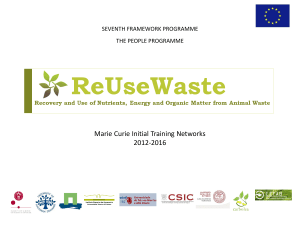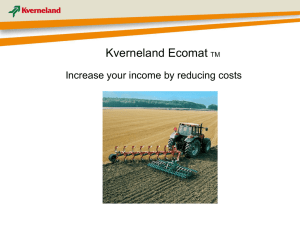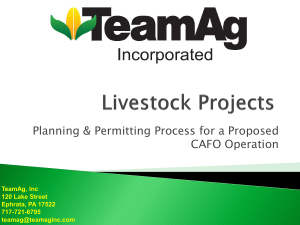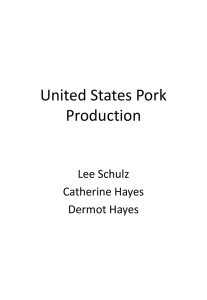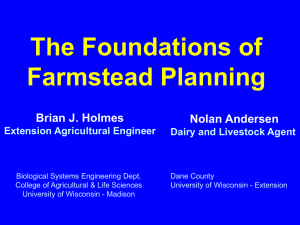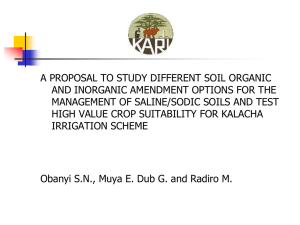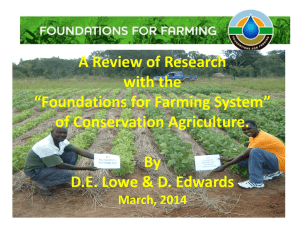- eXtension
advertisement
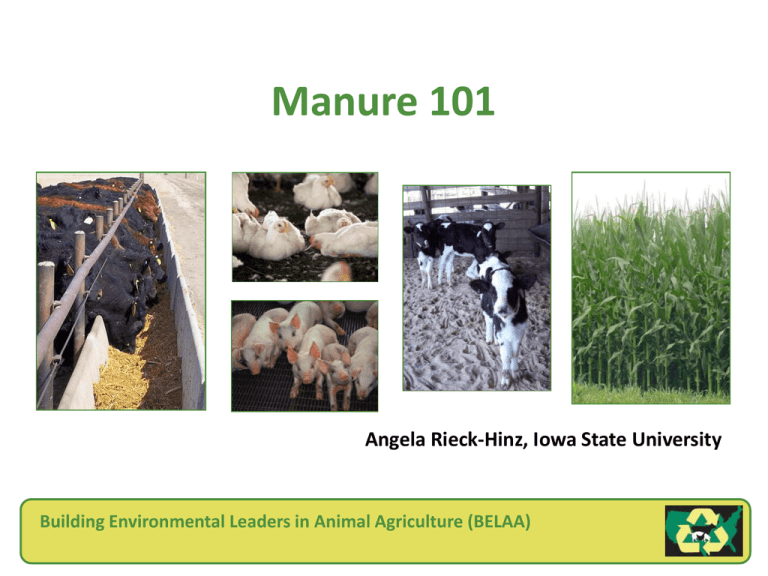
Manure 101 Angela Rieck-Hinz, Iowa State University Building Environmental Leaders in Animal Agriculture (BELAA) Outline • • • • • • • • What is Manure? Production of Manure Forms of Manure Collection/Handling/Storage/Application Manure and Environment Manure Uses Regulations Assistance Building Environmental Leaders in Animal Agriculture (BELAA) Benefits and Challenges to Manure Production and Use Benefits • Readily available nutrient source • All nutrients are supplied for crop/forage/horticultural production • Increase water-holding capacity/infiltration/organic matter of soils • Could be sold or exchanged for goods/profit • Reduces commercial fertilizer inputs Challenges • Odor • Flies • Storage • Handling • Lack of available application area • Not easy to balance nutrients • It can be hard work Building Environmental Leaders in Animal Agriculture (BELAA) What is Manure? • Manure is a mixture of feces and urine and can include other things such as bedding, spilled feedstuffs, feathers, hair and soil • It may also include wash-water from milking parlors or egg-wash facilities, and run-on water. • Manure can be used as fertilizer source, soil amendment, feedstuff, bedding and energy source • Manure from any source can cause water quality pollution if not managed properly Building Environmental Leaders in Animal Agriculture (BELAA) Pasture-based Animals and Manure • Do not overstock • Collection is not necessary (usually) • Even distribution might be needed – Rotational grazing – Move feed and water stations – Collection of manure and re-distribution • Keep animals out streams and ponds • Do not overgraze – Erosion, compaction, runoff Building Environmental Leaders in Animal Agriculture (BELAA) Production of Manure Per Animal Per Day • • • • • • • • • Horse (1,100) Dairy (1,400) Beef (1,000) Swine (150) Sheep (100) Goat (63) Broiler (2) Layer (4) Turkey (20) 50 lb/day 148 lb/day 80 lb/day 9.5 lb/day 4 lb/day 3.5lb/day 0.18lb/day 0.26 lb/day 0.90 lb/day 9 ton/year 27 ton/year 14 ton/year 1.73 ton/year 0.73 ton/year 0.64 ton /year 0.03 tons/year 0.05 tons/year 0.16 tons/year Building Environmental Leaders in Animal Agriculture (BELAA) Manure plus Bedding • • • • Primary use is to absorb moisture Use only what is needed Remove manure and dirty bedding Make sure your bedding source is compatible with your manure handling, storage and land application methods • Make sure you include bedding volume when calculating storage volume needed Building Environmental Leaders in Animal Agriculture (BELAA) Forms of Manure • Solid – With or without bedding/soil additions • • • • Semi-Solid Slurry Liquid Understanding and recognizing forms of manure can help identify manure collection/handling/storage and land application equipment. Building Environmental Leaders in Animal Agriculture (BELAA) Collection/Handling • Have access to equipment that fits your scale of operation Building Environmental Leaders in Animal Agriculture (BELAA) Manure Storage The primary principles of manure storage are: • Store manure when land application is hampered by unsuitable weather/soil conditions • Land-apply manure at times suitable for crop use • Better match producer’s time and labor supply • To protect nearby water sources • Depending on system, can control or reduce odors Building Environmental Leaders in Animal Agriculture (BELAA) Storage • Sized to hold manure between periods of land application • Sized to hold all manure during winter months • Extra storage is always recommended • Storage requirements may be dictated by – State regulations – Design standards if seeking financial assistance – Integrator design standards Building Environmental Leaders in Animal Agriculture (BELAA) Storage Structures Benefits • Separation of manure from animals • Easier collection • Can reduce contact with outside water sources • Can provide storage during inclement weather • Can help “conserve” nutrients* • Can hide manure/aesthetics Challenges • Might need to handle manure more than once • Cost of building and maintaining structures • Odor • Location and sometimes type and size of storage must take into account state or federal setbacks. Building Environmental Leaders in Animal Agriculture (BELAA) Storage Location • Site storage locations near manure sources • Easy access for equipment and during bad weather • Locate in a place where storage can be expanded if necessary • Keep away from low areas, streams, floodplains, or other places water flows • Downwind from neighbors • Use “aesthetics” to hide storage facilities Building Environmental Leaders in Animal Agriculture (BELAA) Types of Storage Structures • Solid Manure Storage – Bedded packs; poultry operations with litter; separated solids; stockpiling and stacking sheds. • Slurry Storage – Under floor pits; earthen basins; roofed or unroofed concrete or steel tanks; • Liquid Storage – Treatment lagoons; open lot runoff holding ponds Building Environmental Leaders in Animal Agriculture (BELAA) Advantages and Disadvantages of selected manure storage systems The following slides offer advantages and disadvantages of certain storage systems. Building Environmental Leaders in Animal Agriculture (BELAA) Solid Manure- Bedded Pack Building Environmental Leaders in Animal Agriculture (BELAA) Solid Manure –Bedded Pack • Advantages No need to build storage Pack can generate heat for animals Depending on cleaning frequency- less bedding needed No rainfall additions Little to no runoff High nutrient density • Disadvantages Need bedding source Animals in constant contact with manure and dirty bedding- can lead to some health concerns Infrequent removal can require more work Flies/Odor Building Environmental Leaders in Animal Agriculture (BELAA) Solid Manure- Stockpiling Building Environmental Leaders in Animal Agriculture (BELAA) Solid Manure-Stockpiling • Advantages • Disadvantages Will compost if managed correctly Temporary storage option Reduces animal contact with dirty bedding and manure Handle manure twice Odors if not managed properly Flies/Rodents Can absorb water Regulations Building Environmental Leaders in Animal Agriculture (BELAA) Solid Manure –Stacking Shed Building Environmental Leaders in Animal Agriculture (BELAA) Solid Manure -Stacking Shed • Advantages Reduce or prevent addition of water Used as a push wall to help collect manure Hide manure/aesthetics • Disadvantages Cost to build storage Equipment Odors Flies Handle twice Building Environmental Leaders in Animal Agriculture (BELAA) Liquid Manure- Below Building Pit Building Environmental Leaders in Animal Agriculture (BELAA) Liquid Manure - Below-Building Pit • Advantages Relatively high nutrient density Low/moderate nutrient loss No rainfall effects May only need to handle manure during land application Disadvantages Cost May have more odor May require ventilation Animal/worker health issues from prolonged exposure to gases May not be appropriate for areas with high water tables or geologic concerns May be difficult to remove solids from liquid pits Building Environmental Leaders in Animal Agriculture (BELAA) Liquid Manure - Lagoon Building Environmental Leaders in Animal Agriculture (BELAA) Liquid Manure- Lagoon • Advantages Provides biological treatment of manure Can be used as source of irrigation water Can provide long-term storage • Disadvantages Possible odors High loss of nitrogen due to volatilization Hard to remove solids Phosphorus may build up in solids Difficult to agitate May not be appropriate for areas with high water tables or geologic concerns Building Environmental Leaders in Animal Agriculture (BELAA) Other Storage Options • Generally for small volumes or daily application – Manure Spreader • Short term for small amounts, or • Daily scrape and haul systems – Garbage cans/wood or metal bins Building Environmental Leaders in Animal Agriculture (BELAA) Land Application Building Environmental Leaders in Animal Agriculture (BELAA) Application • Determine application rate based on nutrient needs of crops • Adequate capacity of application equipment • Calibrate manure application equipment • Achieve uniform distribution • Avoid repeated application in same area • Do not apply manure in the winter • Follow all setbacks or land application separation distances Building Environmental Leaders in Animal Agriculture (BELAA) Off-Site Transfer • Possible solution if lack of storage or application area • Disposal through trash services? • Use in garden/horticultural venues • Distribute to crop farmers • Be aware – Regulations – Transportation Issues – Liability Building Environmental Leaders in Animal Agriculture (BELAA) Manure and the Environment • Generally speaking, manure management and environmental protection should not be at odds • The concept of the nutrient cycle should be the basis for nutrient use. • However, concerns include water quality, soil quality and air quality issues Building Environmental Leaders in Animal Agriculture (BELAA) Manure and the Environment • Water Quality Issues for both Surface and Ground Water Sources – Nitrogen, Phosphorus, Organic Matter, Pathogens – Too much of anything in the wrong place can be a bad thing Building Environmental Leaders in Animal Agriculture (BELAA) Manure and the Environment • Air Quality – Emissions, odor and dust can be generated from the animal production system, the manure collection and storage system and the land application system. – Concerns arise over animal and human health issues and property values Building Environmental Leaders in Animal Agriculture (BELAA) Manure Uses • • • • Nutrient Resources for Crops Energy Production Feedstuffs Other Uses – Asphalt – Erosion control materials – Building products Building Environmental Leaders in Animal Agriculture (BELAA) Nutrient Management Planning • • • • Inventory Sampling and Analysis Application Assessment or Feedback Building Environmental Leaders in Animal Agriculture (BELAA) Nutrient Management Planning • Inventory – Animal Numbers – Manure Nutrients Produced – Crops to be Grown and Yields – Acres Available for Nutrients – Other Nutrient Sources Building Environmental Leaders in Animal Agriculture (BELAA) Nutrient Management Planning cont. • Sampling and Analysis – Take soil and manure samples – Soil Analysis – Manure Analysis • • • • • Nitrogen Phosphorous Potassium pH Moisture Content Building Environmental Leaders in Animal Agriculture (BELAA) Nutrient Management Planning cont. • Application – Prioritize fields based on crop nutrient needs and risk to environment – Apply the right rate – Apply an uniform rate – Apply manure in the right place in the field Building Environmental Leaders in Animal Agriculture (BELAA) Nutrient Management Planning cont. • Assessment or Feedback – Evaluate soil P and K levels over time to determine how manure application affects soil test levels – Use appropriate tests to determine N supply to crops • Examples include the Late Spring Nitrate Test and the Cornstalk N Test – Adjust and refine the process as needed Building Environmental Leaders in Animal Agriculture (BELAA) Manure Regulations • Determine governing body in your state • Determine how your livestock operation is classified • Know how many animals and what animal types are represented on your farm and how those numbers fit into state and federal regulations Building Environmental Leaders in Animal Agriculture (BELAA) Regulations • At the very least: – Know setback distances for land application – Keep manure and wastewater out of surface waters – Apply manure according to a manure or nutrient management plan – Know and follow air quality regulations if they apply in your state – Keep good records Building Environmental Leaders in Animal Agriculture (BELAA) Assistance • The following groups can offer technical and/or financial assistance – State/Federal regulatory agency – NRCS – Local watershed groups – Extension Service – Consulting Engineers, Crop Consultants, Feed Dealers, Local Agronomists Building Environmental Leaders in Animal Agriculture (BELAA) The Scoop on Poop • There are many different types of livestock, poultry and manure systems out there – If you want to start a new operation or expand an existing operation take time to visit different systems and talk to owners about what works and what does not work – Pencil it out to make sure it works – Find trusted advisers who can offer sound advice – Never stop learning or asking questions Building Environmental Leaders in Animal Agriculture (BELAA)


